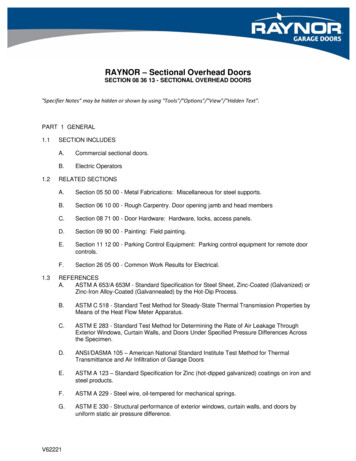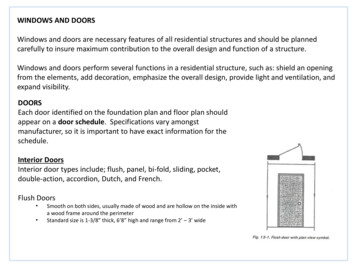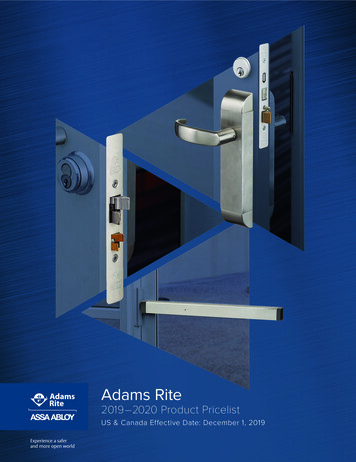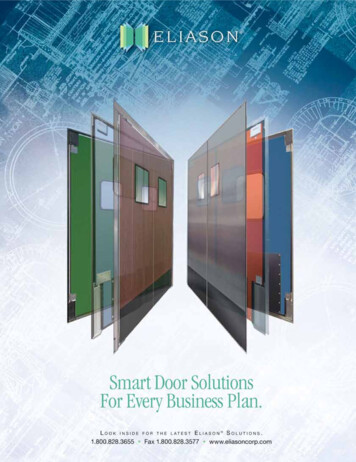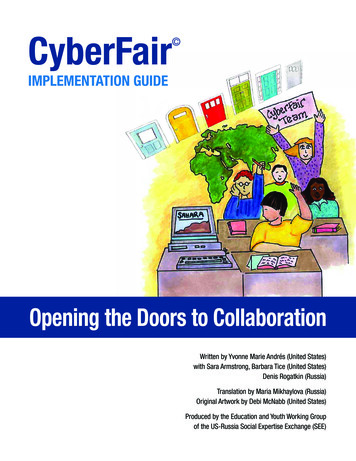
Transcription
Opening the Doors to CollaborationWritten by Yvonne Marie Andrés (United States)with Sara Armstrong, Barbara Tice (United States)Denis Rogatkin (Russia)Translation by Maria Mikhaylova (Russia)Original Artwork by Debi McNabb (United States)Produced by the Education and Youth Working Groupof the US-Russia Social Expertise Exchange (SEE)
CyberFair Implementation GuideThis guide contains materials developed by the Education and Youth Working Group of the US-RussiaSocial Expertise Exchange (SEE).This publication is addressed to school administrators, education thought leaders, organizations, andcommunity-oriented businesses with an interest in implementing CyberFair projects in their community,in support of the new educational standards in Russia and the United States. It reveals new possibilities forcollaboration among schools, communities, nonprofit organizations, and businesses.TA B L E OF CON TEN TSPREFACECyberFair “Opening the Doors to Collaboration” . . . . . . . . . . . . . . . . . . . . . . . . . . . . . . . . . . . . . . . . . . . . . . . . 4INTRODUCTIONAligning Content Standards & Academic Requirements . . . . . . . . . . . . . . . . . . . . . . . . . . . . . . . . . . . . . . . . . . 5Overview of CyberFair . . . . . . . . . . . . . . . . . . . . . . . . . . . . . . . . . . . . . . . . . . . . . . . . . . . . . . . . . . . . . . . . . . . 6CyberFair Community Categories . . . . . . . . . . . . . . . . . . . . . . . . . . . . . . . . . . . . . . . . . . . . . . . . . . . . . . . . . . . 7How CyberFair Helps Youth, Schools, NGOs, & Communities . . . . . . . . . . . . . . . . . . . . . . . . . . . . . . . . . . . . . . . 8Service Learning and Youth Volunteerism . . . . . . . . . . . . . . . . . . . . . . . . . . . . . . . . . . . . . . . . . . . . . . . . . . . . . 9GETTING STARTEDIntroducing CyberFair at Your location . . . . . . . . . . . . . . . . . . . . . . . . . . . . . . . . . . . . . . . . . . . . . . . . . . . . . . 10Organizing a CyberFair Team . . . . . . . . . . . . . . . . . . . . . . . . . . . . . . . . . . . . . . . . . . . . . . . . . . . . . . . . . . . . . 11Selecting a Research Topic Within a Category . . . . . . . . . . . . . . . . . . . . . . . . . . . . . . . . . . . . . . . . . . . . . . . . 12Defining the Project Scope . . . . . . . . . . . . . . . . . . . . . . . . . . . . . . . . . . . . . . . . . . . . . . . . . . . . . . . . . . . . . . . 13Creating a Project Plan . . . . . . . . . . . . . . . . . . . . . . . . . . . . . . . . . . . . . . . . . . . . . . . . . . . . . . . . . . . . . . . . . 14Establishing a Timeline . . . . . . . . . . . . . . . . . . . . . . . . . . . . . . . . . . . . . . . . . . . . . . . . . . . . . . . . . . . . . . . . . 15Preparing Students (Acceptable Use Policies) . . . . . . . . . . . . . . . . . . . . . . . . . . . . . . . . . . . . . . . . . . . . . . . . . 16Preparing Students (Copyright and Citations) . . . . . . . . . . . . . . . . . . . . . . . . . . . . . . . . . . . . . . . . . . . . . . . . . 17IMPLEMENTATIONConducting Research and Collecting Content Assets . . . . . . . . . . . . . . . . . . . . . . . . . . . . . . . . . . . . . . . . . . . 18Organizing Information for Online Sharing . . . . . . . . . . . . . . . . . . . . . . . . . . . . . . . . . . . . . . . . . . . . . . . . . . . 19Designing and Publishing Digital Media . . . . . . . . . . . . . . . . . . . . . . . . . . . . . . . . . . . . . . . . . . . . . . . . . . . . . 20Reflection and Writing the Project Narrative . . . . . . . . . . . . . . . . . . . . . . . . . . . . . . . . . . . . . . . . . . . . . . . . . . 212 CYBERFAIR IMPLEMENTATION GUIDE
IMPLEMENTATION, continuedPreparing for Peer Review . . . . . . . . . . . . . . . . . . . . . . . . . . . . . . . . . . . . . . . . . . . . . . . . . . . . . . . . . . . . . . . 22Conducting the Peer Review . . . . . . . . . . . . . . . . . . . . . . . . . . . . . . . . . . . . . . . . . . . . . . . . . . . . . . . . . . . . . 23Understanding Feedback . . . . . . . . . . . . . . . . . . . . . . . . . . . . . . . . . . . . . . . . . . . . . . . . . . . . . . . . . . . . . . . . 24Publicizing Your Project and Social Media . . . . . . . . . . . . . . . . . . . . . . . . . . . . . . . . . . . . . . . . . . . . . . . . . . . 25Conducting Community Outreach . . . . . . . . . . . . . . . . . . . . . . . . . . . . . . . . . . . . . . . . . . . . . . . . . . . . . . . . . . 26MORE INFOTop Ten CyberFair Implementation Strategies . . . . . . . . . . . . . . . . . . . . . . . . . . . . . . . . . . . . . . . . . . . . . . . . . 27Becoming a CyberFair Affiliate Partner . . . . . . . . . . . . . . . . . . . . . . . . . . . . . . . . . . . . . . . . . . . . . . . . . . . . . . 28Reflections and Success Stories (from USA) . . . . . . . . . . . . . . . . . . . . . . . . . . . . . . . . . . . . . . . . . . . . . . . . . . 29Reflections and Success Stories (Russia) . . . . . . . . . . . . . . . . . . . . . . . . . . . . . . . . . . . . . . . . . . . . . . . . . . . . 30Reflections and Success Stories (Worldwide) . . . . . . . . . . . . . . . . . . . . . . . . . . . . . . . . . . . . . . . . . . . . . . . . . 31Comparison of Russian and American New Educational Standards . . . . . . . . . . . . . . . . . . . . . . . . . . . . . . . 32-34RESOURCEProject Planning Checklist . . . . . . . . . . . . . . . . . . . . . . . . . . . . . . . . . . . . . . . . . . . . . . . . . . . . . . . . . . . . . . . 35(Sample Form) Acceptable Use Policy . . . . . . . . . . . . . . . . . . . . . . . . . . . . . . . . . . . . . . . . . . . . . . . . . . . . . . . 36(Sample Form) Parent Notification Letter . . . . . . . . . . . . . . . . . . . . . . . . . . . . . . . . . . . . . . . . . . . . . . . . . . . . 37(Sample Form) Media Advisory . . . . . . . . . . . . . . . . . . . . . . . . . . . . . . . . . . . . . . . . . . . . . . . . . . . . . . . . . . . . 38AUTHORS & CONTRIBUTORS . . . . . . . . . . . . . . . . . . . . . . . . . . . . . . . . . . . . . . . . . . . . . . . . . . . . . . . . . . . . . 39Downloadable version is available et.org(VIDEO) Intro to OPENING DOORS to Collaboration (English)(VIDEO) Intro to OPENING DOORS to Collaboration (Russian)http://www.openourdoors.comContributors from six continents submitted one hundred video clips for this crowd-sourced,collaborative project, transcending geography, language, age, and technology.Opening Doors Challenge: http://youtu.be/5PugMXdr2FgThis publication was created with thesupport of Eurasia Foundation.CYBERFAIR IMPLEMENTATION GUIDE 3
PR E FA CECyberFair “Opening the Doorsto Collaboration”“Be an opener of doors.” —Ralph Waldo Emerson“Knowledge is of no value unless you put it into practice.” —Anton ChekhovA priority for the US-Russia Social Expertise Exchange (SEE) Education and Youth working group is to be an “Openerof Doors.”Our members strive to support education projects that have the potential to “open the doors” to a world of collaborationand mutual understanding for Russian and American youth, while supporting national education standards.Educators must think about the kind of knowledge and skills that will be most useful decades from now, as innovativetechnologies will continue to change our lives.It is our shared belief that education has a duty to go beyond memorizing facts and taking tests. Education should helpyouth to become creative producers of content, as well as responsible consumers of information. When youth participatein learning experiences that connect them to the real world, they develop both a local and global perspective onimportant issues.When young people collaborate on authentic projects, they think critically, learn to express themselves clearly, and adaptto changing circumstances. Exposure to new ideas allows youth to be more flexible and tolerant, and apply skills thatwill enable them to achieve excellence in school, in the workplace, and in life.We believe that learners should be exposed to the ideas of the “world as a whole” and become engaged in studies thatfocus on various aspects of human experience, such as language (how people communicate), creativity (how peopleexpress their ideas), problem solving (how people find solutions), literature (how people see their own times in thecontext of the present, the past, and the future), history (how the present has resulted from the past), and politics (howpeople have organized, been influenced by, and reacted to the power structures of society).By providing the right inspiration and opportunities, we can help youth to develop communication skills, create multicultural understanding, and prepare youth to be productive and compassionate citizens in a globally connected economy.With these goals in mind, we challenge every student, educator, parent, business, and community member to “open thedoors to collaboration” and participate in CyberFair!SEE Education and Youth Working Group Co-chairs,Denis Rogatkin, Youth Union Doroga, City of Petrozavodsk, RussiaYvonne Marie Andrés, Global SchoolNet-iPoPP, United States4 CYBERFAIR IMPLEMENTATION GUIDE
IN T R O DU CTIONAligning Content Standards& Academic RequirementsDeeper Learning and Analytic Skills: New education priorities, such as the Next Generation Standards inRussia and the Common Core State Standards in the United States, stress the importance of deeper learning andanalytic skills that youth will need to be successful in the future. Rather than simply memorizing facts, students areexpected to apply core knowledge and devise solutions to authentic, real-world challenges.Authentic, Cross-Curricular, and Project-Based Work: New education standards represent a significantchange in the way educators teach and how students show what they have learned. The standards require amore authentic assessment system, expansion of interdisciplinary connections, and development of project-basedlearning that give students opportunities to apply their knowledge in real-world situations. They also introduce newdigital assessments and quantitative methods for measuring student performance that are fundamentally differentfrom traditional paper-and-pencil tests.New Academic Standards: CyberFair supports neweducation standards because youth are engaged inauthentic, real-world learning projects that involvethe use of creativity, collaboration, critical thinking,entrepreneurship, presentation, demonstration,problem solving, research and inquiry, peer-to-peerlearning, and career readiness. CyberFair participantsapply core skills as well as important projectmanagement and time management skills that betterprepare them for success in school and the workforce.Career Readiness and Workforce Skills:CyberFair supports career readiness. The Partnershipfor 21st Century Skills (P21), founded in the USA in2002, is a coalition of business, community, educationleaders, and policymakers advocating for 21st Centuryreadiness in K-12 education. The goal of P21 is to close the profound gap between the knowledge and skills moststudents learn in school and what they need in typical 21st century communities and workplaces. P21 stresses theimportance of core subjects (e.g. reading and language arts, world languages, mathematics, economics, science,geography, history, arts, government, civics), as well as creativity and innovation, critical thinking and problemsolving, communication and collaboration, information and media literacy, and career skills.Read More:Partnership for 21st Century Learning Skills, http://www.p21.org/our-work/p21-frameworkRussian Standards, -state-educational-standardsUS Common Core State Standards, YBERFAIR IMPLEMENTATION GUIDE 5
IN T R O DU CTIONOverview of CyberFairCommunity-Based Storytelling: International CyberFair is ablended learning, project-based version of a traditional World’s Fair— an international exhibition showcasing the industrial, scientific,technological, business, cultural, and artistic achievements of theparticipating nations.Authentic, Real-world Projects: The CyberFair model places strong emphasis on “learning by doing.” Applyingthe theory of constructivism, CyberFair participants construct their own knowledge, and generate meaning fromtheir experiences.Participants of the CyberFair program:1. Produce tangible evidence or “artifacts” of what they learned;2. Reflect and report on their experiences;3. Share the artifacts with an audience of their peers;4. Engage in a Peer Review and receive feedback.Research, Collaboration, and Digital Media Skills: CyberFair incorporates on-site and online collaboration.Working in teams, youth conduct original research and create digital media presentations or “virtual exhibits” (e.g.blogs, websites, videos, podcasts, music, photo galleries) about their community, and share their work online with aninternational audience.Reflection, Evaluation, and Recognition: CyberFair requires students to reflect on their own work and to evaluateprojects submitted by other teams using a special web-based evaluation tool called a rubric. Recognition is given forthe best projects in each of eight categories: local leaders, businesses, community organizations, historical landmarks,environment, music, art, and local specialties.History of Success: The International CyberFair competition has run annually since 1996, with millions of studentsparticipating from 109 countries. Registration begins each October and final projects are due in March. Peer Reviewtakes place in April and winners are announced in May. A library of 3,000 CyberFair projects is currently available onthe Global SchoolNet website.Complete details and instructions can be found on the CyberFair website.Read More:Constructivist Learning, uctivist.htmlInternational CyberFair, http://www.globalschoolnet.org/gsncfProject-based Learning, http://bie.org/about/what pblWorld’s Fairs and World Expositions, http://en.wikipedia.org/wiki/World%27s fair6 CYBERFAIR IMPLEMENTATION GUIDE
IN T R O DU CTIONCyberFair Community CategoriesCyberFair categories focus on important aspects of acommunity, and align with essential knowledgeand skills that students are expected to learn. CyberFairteams are tasked with producing a digital project (e.g.website, blog, video, podcast, song) that documents andshowcases a topic of their choice within one of thefollowing eight main categories:CATEGORY 1: Local ries/cat1.cfm Contributions of famous or important people in your community (e.g. politicians, authors, artists,musicians, sports figures)CATEGORY 2: Community Groups and Special tegories/cat2.cfm Unique, interesting or specific community populationsCATEGORY 3: Businesses and categories/cat3.cfm Businesses or organizations (e.g. Chamber of Commerce, City Hall, hospitals, banks, libraries, Boys & Girls Clubs,civic clubs, stores, shops)CATEGORY 4: Local Specialties, Sports, and ies/cat4.cfm Specialties and unique items or things produced, grown, or raised in your community (e.g. crafts, foods,produce, flowers, animals) Sports, games, or health programs (e.g. surfing, skiing, rock climbing, jump rope jingles, sporting events,health awareness, substance awareness programs)CATEGORY 5: Local Attractions (Natural and gories/cat5.cfm Natural and man-made attractions (e.g. rivers, oceans, mountains, museums, zoos, parks, campgrounds)CATEGORY 6: Historical gories/cat6.cfm Historical landmarks (e.g. missions, churches, battlefields, architecture, street names)CATEGORY 7: Environmental Awareness and ies/cat7.cfm Environmental concerns or special efforts to promote a sense of awareness and action (e.g. disaster preparedness,floods, earthquakes, hurricanes, beach erosion, solid waste management, water, air, noise pollution)CATEGORY 8: Local Music and Art es/cat8.cfm Music and musicians, and artistic and cultural forms that are important elements of a community’s experience(e.g. dance, festivals, songs, ceremonies, sculpture, painting, crafts)CYBERFAIR IMPLEMENTATION GUIDE 7
IN T R O DU CTIONHow CyberFair Helps Youth, Schools,NGOs & CommunitiesCommunity and Youth Engagement: In a world that often seems too big to comprehend, International CyberFairoffers a remarkable opportunity for young people to use the Internet to bring their community closer to others — and toexpand their own experiences.Blended Learning and Collaboration: CyberFair involves offline and online learning activities that empower students,teachers, schools, youth organizations, and local communities to share resources, establish partnerships, and worktogether to build strong and supportive relationships. Throughcollaboration and knowledge-sharing, youth learn about the needsof their community, the challenges their local leaders face, localjob opportunities, and also deepen their understanding of theircommunity history and culture.Youth can act as student ambassadors by working with localleaders, local artists, local businesses, and the entire communityto show the world what is special about their place. For example,youth can meet local artists and musicians, interview them, tapetheir music, photograph their art, thus showing the world theircommunity’s cultural heritage. Students can collaborate with localcivic organizations, chambers of commerce, farmers, or businessleaders to show the world the things they make and grow.Preserving Best Practices and Promoting Exemplary Models: CyberFair benefits individual participants personally,while contributing to the greater community. Exemplary models are preserved and an institutional history is createdabout the special people and programs in participants’ own local communities. These models serve as benchmarks,best practices, and inspiration for future projects.Thinking About the Future: Youth participating in CyberFair learn what it means to be part of a community —both locally and globally. Youth are challenged to prepare for the future by thinking about their own future plans, theconditions that will affect the future of their community, and issues of global importance.Opening Doors: Schools and youth organizations from around the world are encouraged to “open their doors” tounderstanding by participating in CyberFair.Read More:(VIDEO) Intro to OPENING DOORS to Collaboration, http://www.openourdoors.comFutures Education, 8 CYBERFAIR IMPLEMENTATION GUIDE
IN T R O DU CTIONService Learning and Youth VolunteerismThe “Open Doors” project, implemented by the Education and Youth working group of the US-Russia Social ExpertiseExchange (SEE), provides a unique opportunity to “open the doors” and exchange ideas on topics of mutual interest —such as youth volunteerism and service learning.Service learning is a teaching and learning strategy that integrates meaningful community service with academic studyand reflective practice. It aims to enrich learning, build civic engagement, and strengthen communities.Service Learning and Youth Volunteerism: Service learning and youth volunteerism programs can be found in everycountry around the world. Youth who participate in these projects are more likely to feel connected to their communities,perform better in school, and feel empowered to become “agents of change.”Communities enjoy more than financial benefits when youth contribute toservice projects. When youth volunteer, they tend to continue volunteeringas adults. The community gains a generation of young people who careabout where they live and are willing to make a commitmentto improvement.In the United States, service learning combines academiccoursework with some sort of voluntary service provided tothe community. In 2006, the Community Service LearningAdvisory Council reported that “one-third of all publicschools and half of all high schools use service learning.”Campus Compact, an association of 1,200 Americanhigher education institutions, reports that 95 percent of itsmembers offer service-learning courses (2012).In Russia, while service learning is not common,there are numerous programs that support and promoteyouth volunteerism. Programs help participants learnthe basics of volunteer activities, teamwork, conflictresolution, working with the media and fundraising,and project implementation.Read More:International Center for Service-Learning in Teacher Education, http://educationprogram.duke.edu/ICSLTENational Service-Learning Clearinghouse (NSLC), http://gsn.nylc.org/Service Learning, http://www.educationreporting.com/resources/CLP Billig article.pdfVector of Volunteerism Web-portal, http://www.kdobru.ru (Russia)Volunteerism Development Centre, http://dobrocentr10.ru (Russia)CYBERFAIR IMPLEMENTATION GUIDE 9
G E TTIN G STA R TEDIntroducing CyberFair at Your LocationTypically, a teacher, a parent, a school administrator, a business leader, or a community member introduces CyberFair toa local school or organization.The best way to get started is to: Schedule a one-hour meeting. S end an invitation to all potentialcontributors and participants. C reate a brief slideshow presentationthat explains how CyberFair worksand the benefits of participating. S how some of the existingCyberFair videos. S how and discuss some of the pastCyberFair projects. Have a group discussion to define the scope of the project and to answer questions, such as:—— Who will serve as project leader?—— During what time frame will the project take place?—— What will the topic be?—— Who else should be invited to contribute?—— W hat tasks are involved (e.g. research, interviewing, writing, videotaping, video editing, photography,image-editing, web publishing)?—— What are the benefits of a CyberFair project for students, organizations, and communities?—— What technologies and tools will be used?—— How will the students be evaluated?—— Will there be any prizes or incentives offered?—— How will the completed project be shared with the community? Create a project plan and a timeline. Send periodic updates to participants via email (typically weekly). Schedule periodic follow-up meetings to monitor the progress of the project.10 CYBERFAIR IMPLEMENTATION GUIDE
G E TTIN G STA R TEDOrganizing a CyberFair TeamCyberFair is a collaborative project with teamscomprised of a variety of people who contribute toa single CyberFair project. Teams typically consistof students, teachers, parents, mentors, andcommunity members.The number of team members can range from two to hundreds. Part of the learning experience is for the organization tocome to a consensus in choosing the team members, a project topic, the scope of the project, and a realistic work plan.Teams can be formed through a site advisory committee (be sure to include the appropriate administrator), StudentAssociations, Parent Teacher Organizations, after school or school enrichment programs, Community Technology Centers,Boys & Girls Clubs, and libraries.Within schools and organizations, participants can be grouped in a variety of different ways, based on defined purposesand curricular needs. Below are some examples:Individual Classrooms or Community Organizations Students from one class within a school or organization conduct all of the project activities with the teacher servingas the project leaderVertical Teaming Students from one subject area across several grade levels participate. For example, 7th, 8th, and 9th gradeLanguage Arts classes from one school or organization contribute, or 4th, 5th, and 6th grade Social Studies classesfrom several schools or organizations contribute. One teacher may lead the project from each grade level or school,with one overall designated facilitator or team leaderHorizontal Teaming Students from the same grade level participate. For example, all 10th grade classes in the school participate, withone teacher serving as a designated facilitator, or all 9th grade students from several schools participate with adesignated team leaderSpecial Populations Students from one special population (e.g. student council, academically gifted, special needs, independent study)within the school or organization participate. Alternatively, groups from several populations work together tocontribute to the project, with one teacher serving as a designated facilitator or team leaderCYBERFAIR IMPLEMENTATION GUIDE 11
G E TTIN G STA R TEDSelecting a Research TopicWithin a CategoryCyberFair categories are intentionally broad and focuson important aspects of any community, as well asalign with essential knowledge and skills that studentsare expected to learn. Discussion questions, starteractivities, and past project examples are provided foreach of the categories.Once you review the main category options, you can choose the category that best fits your project idea and then definea research topic.Steps for selecting a category and defining a research topic:1. M eet with your team to review and discuss the main CyberFair category options to determine the categorythat is the best fit for your students, school, or organization.2. Select one of the main category options for your project.3. Define a research topic idea for your project that fits within that category.4. D etermine the information that you must collect to produce a digital project that supports your researchtopic (e.g. website, blog, video, podcast, song, interview).Click links for more details about each category: CATEGORY 1: Local Leaders CATEGORY 2: Community Groups and Special Populations CATEGORY 3: Businesses and Organizations CATEGORY 4: Local Specialties, Sports and Health CATEGORY 5: Local Attractions (Natural and Man Made) CATEGORY 6: Historical Landmarks CATEGORY 7: Environmental Awareness and Issues CATEGORY 8: Local Music and Art Forms12 CYBERFAIR IMPLEMENTATION GUIDE
G E TTIN G STA R TEDDefining the Project ScopeWhen it comes to project planning, defining the Project Scopeis the first important step. Defining the Project Scope can becompared to designing a house, where you must decide how bigthe house will be and how many rooms the house will have.The Project Scope identifies the project goals, deliverables, andconstraints and is the basis for the Project Plan discussed on thenext page (e.g. resources required and amount of time needed toaccomplish those goals).Team members should work together to define the Project Scopeso that you can allocate tasks and give team members thedirection they need to deliver the project on time. When definingthe Project Scope, it is best to specify the minimum results thatyou want to achieve.TIP: The biggest mistake that teams make is to be too ambitious and attempt to accomplish too much. If you findyourself with extra time or resources, you can always add to your project.Project Scope Item:Examples:Project Goal Description – a The goal of our project is to showcase local leaders who are doingbrief project overview; the story good things for our community.you are telling.Project Deliverables – a list of results that will be produced bythe project. We will conduct four or more video interviews with leaders and postthe videos online.We will make video and slide presentations for the School Boardand City Council.Project Constraints – a list of needs, limitations, or challenges(such as time frames, resources, and physical or technicalconstraints). We have a total of six weeks to complete our project; we will loseone week due to testing.We must reserve computer time in the media center to do researchand edit our videos.We will need a video camera, a high quality microphone, camera lights,and a tripod.We must find someone with video editing knowledge to mentor us.CYBERFAIR IMPLEMENTATION GUIDE 13
G E TTIN G STA R TEDCreating a Project PlanCreating a detailed Project Plan provides the guidelines you need to ensure that you have the time and resources youneed to complete your project. The Project Plan should include:A. Resources Needed: What resources are required to complete your project?Examples:PeopleResourcesMake a list of everyone who will be involved in the project, including administrators,tech support, mentors, community members, parents, etc.TechnologyResourcesDecide what kinds of technology you will use (e.g. phones, cameras, computers, microphones,video editing software, web hosting, social media).OtherResourcesList any other resources you might require (e.g. transportation to locations, permissionto use images or music).B. Risk Analysis: What might possibly go wrong? If so, how will you handle the situation?Examples:Computer or Internet connectionstops working.We can use computers at the media center or city library. We willkeep back-up copies of all our work.Team member drops out, gets illor moves away.We will assign a minimum of two people for each job.Unexpected weather conditions (e.g.snowstorm, hurricane, flood) as wellas possible scheduling conflicts (e.g.testing times and vacations).We will budget additional time to complete each task and to allow forunanticipated issues. We will work on the most important parts ofour project first.C. Evaluation and Assessment: How will the success of your project be evaluated?Examples:Self-AssessmentHow will students assess their own projects? What will make them feel that they dida good job and accomplished their goal?TeacherEvaluationHow will you evaluate the projects (e.g. or
blogs, websites, videos, podcasts, music, photo galleries) about their community, and share their work online with an international audience. Reflection, Evaluation, and Recognition: CyberFair requires students to reflect on their own work and to evaluate projects submitted by other teams using a special web-based evaluation tool called a rubric.


